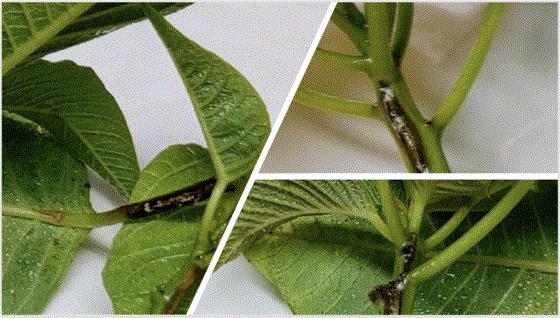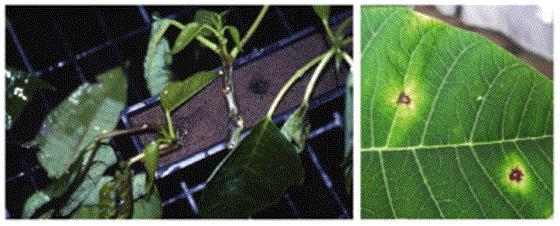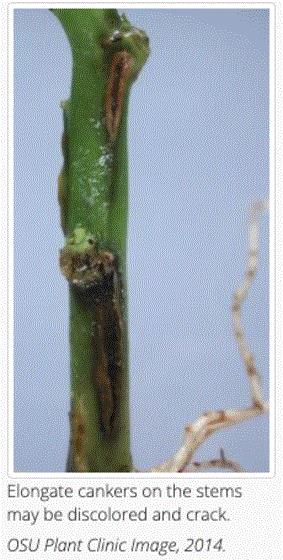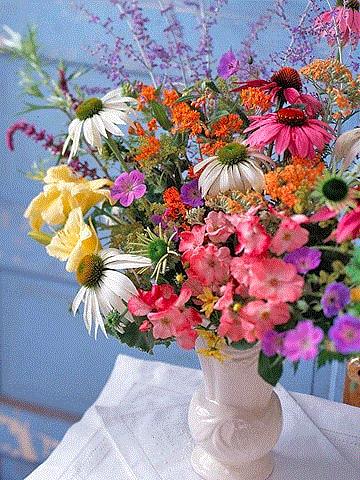Video: Poinsettia Pest & Disease Control in the Early Stages
In THIS VIDEO, presenters James Doukas, Jason Twaddell and Gary Vollmer from Ball Seed and Selecta One focus on fungus gnat control, and avoiding Erwinia and Botrytis, to help you in the early stages of your poinsettia crop.

For insects, primarily fungus gnats, our experts recommend cultural, chemical and biological methods to control problem pests. Early in production (and throughout the majority of crop stages) your best bet is to focus on these three methods of prevention: 1) keep your zones algae free, 2) monitor closely using sticky cards and 3) have a solid moisture management strategy. If things get out of control, there are chemical and biological options available.
For the disease portion of the video, a lot of time is spent on Erwinia, now called Pectobacterium carotovorum, and Botrytis. Like with insects, prevention is the key. Ways to minimize risk include preventative chemical controls and balancing your mist applications.
This is a quick six-minute video that’s surely worth a watch!
Remember, we have more than 30 videos in our "In the Break Room" series that take you from the first days of poinsettia prop all the way up to shipping and beyond. You can find all of the videos in one handy PLAYLIST.

Todd’s Tip of the Week: Bacterial Disease Management on Poinsettias
Usually, I work with my buddy Nick Flax, a technical services expert at Ball, to share a concern that’s come up during one of his numerous calls with growers across North America. This week, Dr. Todd Cavins, another Tech On Demand colleague, wants to get in on the action and share what he’s seen while visiting greenhouses the past few weeks.
PROBLEM: It’s the heart (or heat, depending on where you live) of poinsettia propagation time right now, and while there are many factors that go into to successful propagation, let’s zoom in on bacterial disease management.
TODD’S TIP: There are several bacteria that can wreak havoc on your crop, because the warm and wet conditions poinsettias need for propagation are also well-suited for bacterial growth. Let’s start by running through most of them, and then I’ll share some ways to manage them if and when they occur.
The primary poinsettia bacterial pathogen is Erwinia Soft Rot (renamed Pectobacterium carotovorum). This soft rot usually is present at the base of the stem and is evident a few days after sticking, with black and sometimes smelly rotten tissue. It’s by far the most common disease of poinsettias in propagation, and prevention (starting clean and applying preventative treatments) and temperature management (keep temps under 90F) are key.

One disease we see a few cases of each year is Poinsettia Stem Canker (shown in the photos) caused by the pathogen Curtobacterium flaccumfaciens pv. poinsettiae. Fortunately, this one is a slow grower and doesn’t rapidly wipe out a crop. However, from time to time you’ll spot the black water-soaked stem lesions that form a canker that may even split the stem. Sometimes leaf spots are also present. With good sanitation, consistent preventative bactericides, and good environmental management this one is generally manageable.
There seem to be a lot of bacterial leaf spots, and poinsettia unfortunately has one specific to it: Xanthomonas arboricola pv. poinsettiicola. This one has typical Xanthomonas symptoms of a water-soaked spots or lesions that then become dark brown and often have a bright yellow halo as they age on the leaves. With it being spread by splashing water, it can be challenging to control if an outbreak occurs in propagation.
Pseudomonas viridiflava is another bacterial stem canker and we can pretty much copy and paste the information from Curtobacterium here. Like the others, plant wounds really increase the susceptibility to this pathogen, which thrives in warm, wet conditions.
How do these spread? The source of inoculum could be the input itself or surrounding live or dead plant material, splashing water, blowing dust, dirty hands or tools. There is a potential for spreading not just during propagation but also at transplanting, cleaning and pinching stages.
What are some things to address culturally? First thing is to start clean, with a major emphasis on sanitation of any area the plants will be in or near.
Once on the bench, the goal is to get the plants out of propagation ASAP, to remove them from the optimum bacterial growing conditions.
During propagation, don’t water-log the substrate (if a big callus forms, it’s too wet). Once the callus forms (and especially when root initials are present) significantly reduce the mist. Choose very fine mist nozzles—the goal is to humidify the air and prevent water loss, not to wet the leaves or substrate.
How about other control options? Top of the list are copper sprays, which are most effective, according to plant pathologists. There are also a growing number of biological controls that have suppressive effects, such as Cease or Rhapsody (Bacillus subtilis strain QST 713) and Triathlon (Bacillus amyloliquefaciens strain D747). Agri-Mycin 50 is a product that is also labeled for control of many of these bacterial pathogens in the greenhouse.
A newer chemical, Postiva, while being primarily a fungicide, has also been promoted as suppressive to bacteria. Most growers find that turning off the mist after application to allow contact or penetration time is critical. You may find that earlier morning is the best time to do this, before the light intensity and heat increase.

Poinsettia Disease: A Timeline
Most poinsettia crops are just starting off at the moment, which makes it ultra-critical to begin clean and keep a close eye out for any diseases. Water management is the name of the game right now and is honestly the best way to avoid early issues like Erwinia (renamed Pectobacterium carotovorum) and Rhizoctonia.
But vigilance is critical throughout the entire crop cycle, as different diseases can strike at any time. Ann Chase, owner of Chase Agricultural Consulting, is always one of my go-to experts on all things disease, and while researching content for this week, a fantastic article she wrote a while back came to my attention.

In POINSETTIA DISEASE TIMELINE, Ann takes you through all stages of poinsettia production, discussing specific disease risks and offering ways to reduce potential losses. Starting with propagation and moving on to early-season, mid-season and late-season production, she shares a virtual tutorial on crop diseases. The article concludes with a look at Pythium root rot, which she calls “a disease for all seasons,” because it can appear even as late as the day you ship your crop.

Xanthomonas on Poinsettias
One of the top poinsettia diseases Todd mentioned in his tech tip above is Xanthomonas. In a 2021 GrowerTalks article, Margery Daughtrey, a senior extension associate at Cornell, covered this disease in detail. She discussed a handful of different greenhouse crops that often suffer from Xanthomonas, including poinsettias. Here’s what Margery had to say:

Xanthomonas disease on poinsettias is especially problematic during propagation, as the environmental conditions (humidity, moisture and warmth) during this stage of a poinsettia’s production sequence are most conducive to bacterial infection and spread. The vein-bounded leaf spots that Xanthomonas causes are disfiguring and are a trial for the finishing grower.
Putting a single name on the pathogen is difficult with poinsettia. Xanthomonas arboricola pv. poinsettiicola is the primary name in use, but other Xanthomonas species can be associated with poinsettia disease as well, as shown by research in Florida in 2015. Meanwhile growers cope with disease management using the few tools at their disposal.
For more on Xanthomonas, check out EXAMINING XANTHOMONAS.

More Poinsettia Disease Info from UMass
I’m sure you get the picture by now: Poinsettias are susceptible to a lot of diseases and managing this risk is of utmost importance if you want to ship beautiful and healthy plants to market. There’s little margin for error, due to … well, margins. Part of the challenge is the long crop time, as well as finicky environmental needs throughout the different stages.
University of Massachusetts Extension put together a super-comprehensive fact sheet on poinsettia disease. If you want one document to share with your team to help quickly identify issues, this is one of the best.

In DISEASES OF POINSETTIAS, UMass covers a wide range of diseases, from blights and rots to foliar and stem diseases. Here’s a list of what’s included, but I encourage you to refer to the full fact sheet.
-
Bacterial blight and cutting rot
-
Pythium root rot
-
Rhizoctonia stem rot
-
Botrytis cinerea
-
Powdery mildew
-
Poinsettia scab
-
Phytophthora
-
Rhizoctonia root and crown rot
A Closer Look at Poinsettia Bacterial Canker
Poinsettia stem canker (Curtobacterium flaccumfaciens pv. Poinsettiae) was mentioned above, but it is a disease with which you might not be too familiar. I found an ENTRY in the Pacific Northwest Pest Management Handbook focused specifically on this disease that is worth sharing before I wrap up this week’s newsletter. Here’s the complete info:

Cause: Curtobacterium flaccumfaciens pv. poinsettiae, a bacterium that can be spread by cutting tools and hands working from infected to healthy plants, splashing water, and in contaminated growing media, Infection of leaves occurs through stomates. Warm growing conditions and high-nitrogen fertility have been associated with the disease.
Symptoms: Water-soaked to brown streaks on stems can extend into petioles. Cankers also may girdle the stem. Spots and blotches may be on leaves, which fall prematurely. Woody stems may show yellowed cortex and darkened vascular tissue. If severe, stems may crack, and an amber-color bacterial ooze may develop.
Cultural Control
-
Scout regularly and remove and destroy infected plants.
-
Avoid overhead irrigation or any practice that keeps plants wet for extended periods of time. Individual drip watering of pots can also help.
-
Keep humidity as low as practical.
-
Wash hands and keep cutting tools disinfected.

Finish Line …

Well, that was sure a newsletter filled with doom and gloom. I apologize for that. But my goal was to present a lot of disease information to help you minimize risk and loss.
How about something much more positive—beautiful blooming cut flower perennials perfect to slot into your production mix! There’s a live webinar next Wednesday where you’ll hear about perennial cut flowers from a range of the world’s best breeding and producing companies, including Benary, GET Group, Green Leaf Plants, Darwin Perennials and Walters Gardens. Best of all, it’s timed perfectly to bring in new varieties as we head into the late summer/fall planting season. Your entire cut flower team will benefit from this GrowerTalks webinar, brought to you by Ball Seed.
REGISTER NOW and tune in Wednesday, August 17, at 1 p.m. Eastern/Noon Central/10 a.m. Pacific.
Please feel free to send your comments, constructive criticism and topic ideas to me at bcalkins@ballhort.com.

Bill Calkins
Editor - Tech On Demand
This email was received by you and 25,909 other fine subscribers!
If you're interested in advertising in Tech On Demand, contact Kim Brown ASAP and she'll hook you up.